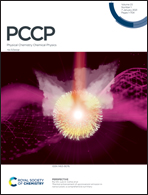Infrared photodissociation spectroscopic investigation on VO+ and NbO+ hydrolysis catalyzed by water molecules†
Abstract
We investigate the hydrolysis of vanadium/niobium monoxide cation (VO+/NbO+) with water molecules in the gas phase. Cationic argon-tagged intermediates, TMO(H2O)nArm+ (TM = V, Nb; n = 1–2, m = 1–2), are prepared for examination using infrared photodissociation spectroscopy. The structures of the intermediates are elucidated by comparing them with simulated spectra. VO(H2O)Ar+ or NbO(H2O)Ar+ (for n = 1) is intrinsically a hydrated adduct, represented by H2O–VOAr+ or H2O–NbOAr+, rather than a dihydroxide, V(OH)2Ar+ or Nb(OH)2Ar+. However, when a second H2O molecule is involved (for n = 2), the dihydroxide V(OH)2(H2O)Ar+ and trihydroxide HNb(OH)3Ar+ are formed. In this process, the six-member cyclic transition state formed by two H2O molecules markedly reduces the hydrogen transfer energy barrier based on our calculations. This work provides more precise experimental evidence for the Grotthuss-like mechanism proposed in the studies of hydrolysis and tautomerization reactions.



 Please wait while we load your content...
Please wait while we load your content...